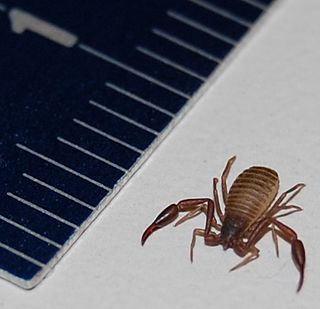
Pseudoscorpions, also known as false scorpions or book scorpions, are small, scorpion-like arachnids belonging to the order Pseudoscorpiones, also known as Pseudoscorpionida or Chelonethida.
Fissilicreagris is a genus of pseudoscorpions in family Neobisiidae, first described by Božidar Ćurčić in 1984.
Menthidae is a family of pseudoscorpions, first described by Joseph Conrad Chamberlin in 1930.
Bochicidae is a family of pseudoscorpions distributed throughout the Americas from Texas and Mexico to South America, from the Antilles to Venezuela, Guyana and Brazil, as well as in Europe. Members of the family can be diagnosed mainly by features of the claws, notably the presence of exactly 12 trichobothria on each claw and a long, as opposed to short, venom duct. Some species live in caves while some are surface-dwelling.

Chernetidae is a family of pseudoscorpions, first described by Anton Menge in 1855.

Garypinidae is a family of pseudoscorpions, first described by Eugen von Daday in 1889.
Atemnidae is a family of pseudoscorpions, first described by Kyukichi Kishida in 1929.

Chthonius is a genus of pseudoscorpions, first described by Carl Ludwig Koch in 1843.
Garypidae is a family of pseudoscorpions, first described by Eugène Simon in 1879.

Garypus is a genus of pseudoscorpions in the family Garypidae. It was described by German arachnologist Ludwig Carl Christian Koch in 1873. The species are found mainly in tropical and subtropical areas, where they occupy supralittoral and littoral zones in seashore habitats.

Cheliferidae is a family of pseudoscorpions in the order Pseudoscorpiones, first described by Antoine Risso in 1827.
Ideoroncidae is a family of pseudoscorpions belonging to the order Pseudoscorpiones. Members of the family are known from Asia, Africa, western North America and South America.

Withiidae is a family of pseudoscorpions, first described by Joseph Conrad Chamberlin in 1931.
Lagynochthonius is a genus of pseudoscorpions in the family Chthoniidae. It was described in 1951 by Austrian arachnologist Max Beier.

Tyrannochthonius is a genus of pseudoscorpions in the family Chthoniidae. It was described in 1929 by American arachnologist Joseph Conrad Chamberlin.
Sathrochthonius is a genus of pseudoscorpions in the family Chthoniidae. It was described in 1962 by American arachnologist Joseph Conrad Chamberlin.
Ideoblothrus is a genus of pseudoscorpions in the Syarinidae family. It was described in 1892 by Italian naturalist Luigi Balzan as a subgenus of Ideobisium.
Dactylochelifer is a genus of pseudoscorpions in the family Cheliferidae, first described by Max Beier in 1932.

Geogarypus is a genus of pseudoscorpions in the Geogarypidae family. It was described in 1930 by American arachnologist Joseph Conrad Chamberlin. The genus has a cosmopolitan distribution.









